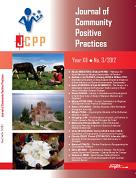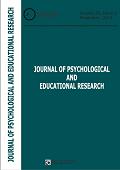Messages from the Castle of Solitude
Poruke iz zamka samoće
Czeslaw Milosz, Drugi prostor, Naklada ZORO, Sarajevo-Zagreb 2008. Prevela Marina Trumić
More...Czeslaw Milosz, Drugi prostor, Naklada ZORO, Sarajevo-Zagreb 2008. Prevela Marina Trumić
More...James Wood, How Fiction Works, Farrar, Straus and Giroux, New York, 2008.
More...Czeslaw Milosz, Drugi prostor, Naklada ZORO, Sarajevo-Zagreb 2008. Prevela Marina Trumić
More...
Keywords: Mentor training; positive youth development; sociocultural and activity theory
The purpose of this paper is to elicit a richer conversation for youth development practitioners and academic researchers related to the approach of youth mentoring training based on Vygotsky’s (1967) sociocultural and activity theory. More specifically to conceptualize and guide youth mentoring research, particularly in inner-city communities where the environments can be most challenging to the health, social and academic development of young people. Recently, there has been an increasing call for youth development researchers to direct their efforts toward solving contemporary social problems that plague today’s youth, particularly in environments that are most challenging to the well- being and academic development of our young people. While youth development practitioners are seen as being on the “front line” and continuously engaged in this endeavor, academic institutions are sometimes viewed by social activists as being self-serving and not fully committed to such endeavors. Using the principles of activity theory, this paper advances previous literature proposing a participatory paradigm as a basis for shared youth development work between practitioners and academic researchers. The paper describes the elements of a participatory youth mentoring training program and presents a case example to demonstrate its’ characteristics
More...
Keywords: land-lost farmers; resistance; interests-striving; struggle by order
Assistant professor at the School of Management, Beijing Normal University, China. She received her Ph.D. in Sociology from the University of Aberdeen, UK and specializes in political and legal sociology, social policy and administration. Her research focuses on rural land expropriation and compensation, the interaction between land-lost farmers and the local authorities in China
More...
Keywords: youths; sample design; random route; electoral register; systematic sampling
This paper looks into methodological issues of sample design for a specific target population: Romanian youths (aged 16-35) that reside in rural areas. The first part of the paper will provide an overview into general issues that come from demographic trends, such as the overall population decline and especially the wave of emigration to Western Europe, and the pros and cons of the most widely used sampling techniques in Romania. The stages of the survey design itself comprise the second part. The most challenging part was how to reduce undercoverage problem by putting forward a sample frame, namely fieldwork procedures to identify as many elements of the target population as possible under real-life conditions. Multiple solutions were taken into consideration, before choosing one after field testing. The final part features an analysis of the survey focusing on the outcome of the sample design.
More...
Keywords: social exclusion; improving the situation of minorities; racial; creed,
As Edwin Alderson, a prominent North Carolina educator stated biracial organizations attracted "plain people ...demanding their share in the government, and their right to be trained for its responsibilities" and created more self-reliant and resourceful people who were wiser when it came to local government. I found Beckel's book reads like an interesting historical story about how North Carolina was affected by civil equality. Beckel starts out her book with an Introduction about biracial relationships. This led to interracial cooperation, and eventually influenced North Carolina organizations. The State’s organizations were massive, and the North Carolina Knights and the Alliancemen had plans to pass some labor laws and get involved politically. At this time, around 1890, the Knights of Labor has 250 locals in 50 counties with the members half and half, Black and White. The Alliance had 55,000 Blacks and 90,000 Whites. In the last chapter "Race and Home Rule," (p. 178) Beckel shares with us that the voting rights were expanded for both the Blacks and the Whites. In conclusion, Beckel tells us: "Many of the state's most energetic citizens simply left for what they hoped would be greater rights and opportunities outside North Carolina."(p.211). In 2010, North Carolina statistics showed 21.6% of the registered voters are Black, where there are 73.2% registered voters who are White.
More...
Keywords: Organizational change; Internal and external factors; European
Researchers in the sociology of organizations are increasingly attracted in recent years, the subfield of organizational change, the speed with which new types of organizations appear and the speed with which the change or even disappear, justifying the increased interest. The present study includes a theoretical approach on the organizational change issues and an analysis on some semi structured interviews with Environmental Guard (Garda de Mediu) managers. «Interrogation» and the interpretation of the interviewees’ speeches will be made in terms of their attitude towards the changes made in their organization, alongside with Romania joining the European Union. In this analysis a part of the data collected through research undertaken in the CNCSIS 707 Grant “The public construction of Europeanization. Institutional practices and adjustment to European norms”. The research and scientific diagnoses dedicated to the organizational development processes reveals special emphasis to be placed on issues like: change agents, internal and external factors of change, new change models – Learning Organization. The analysis of the interviewees’ speeches (two deputy chief commissioners and three managers) show the importance of creativity in the adaptation process of Romanian institutions to the European regulations as well as acquisition of some procedures which led to obtaining good results in managing environmental issues by other member states in the European Union. Also worth mentioning are the concerns towards the local aspects of the environmental field but also to the necessity of connecting change objectives with financial and human resources.
More...
Keywords: Tourism; Regional development; South-West region; Macedonia
As one of the greatest sources for development, tourism is detected by many undeveloped and developing countries as the only way-out for economic prosperity. This research aims to investigate tourism contribution to regional development in Macedonia, highlighting the South-West region as the best practice. In particular, the paper makes an attempt to explore and compare eight planning regions from tourism prospective, pointing to the best one according to up-to-date results. For this purpose, it reports on analyses based on stylized facts obtained from secondary data spreading over a sample period from 2004- 2011. The outcomes point to the fact that the South-West region is the leading statistical region in Macedonia when referring tourism and regional development issues. So, the paper strongly recommends this empirical evidence as good example for boosting regional development through tourism application. Furthermore, it urges the need for identifying effective framework for mitigating modest results and creating sound public policies. Additionally, the contribution of this paper lies in the fact that it enriches the poorly-developed empirical academic work within this scientific area in Macedonia.
More...
Keywords: Consumption patterns; responsibility; prevention policies; positive practices
The current rhetoric together with the ecologist practices from the developed societies might give the impression that mankind reached a rather high level of awareness about the risks which the preservation of the consummatory behaviour generates on the rural environment, implicitly on the quality of the global life, reaching both the present generations and the future ones. Can any act of consumption be truly free and unlimited, just in the name of the liberty of manifestation of the person who, at a particular moment, may buy access with the money he/she can afford to pay? Which are, actually, the consequences of consumption acts that may seem insignificant or benign and which the consumer is often unaware of? What are some countries doing to increase the awareness and to decrease the unwanted consequences of some categories of consumption? Such questions and other ones are answered by this article.
More...
Keywords: International students; education; sustainability; perceptions; future
International tertiary students could be some of the future inhabitants of New Zealand. They could be the leaders of tomorrow and it is important for a tertiary institution to determine what their perceptions, attitudes and behaviours are towards sustainability. Some similarities and differences of opinion were identified and discussed between the different nationalities, religions and ages between the two age groups under 20, and 20 to 39 years of age. Comparisons resulting from the 2011 data to identify trends in student approaches to sustainability issues add value to this research. This study determined that the demographic factors affects an individual’s thinking patterns to some extent, and the different religions have similar perceptions regarding protection of natural resources, limited resources and pollution caused by various sources. The research is based on the assumption that positive attitudes lead to positive behaviours and aims to establish what people’s attitudes towards sustainability and the environment are. The results show the development of a positive trend in terms of thinking and the behaviour towards environment conservation. Recommendations for tertiary institutions form the last section before the conclusions.
More...
Keywords: life quality; schizophrenia; occupational status; educational level
Increased self-esteem, developed facilities of participation to the community life and extra satisfaction insures a superior life quality for the patient diagnosed with schizophrenia.The study includes 150 participants divided in 3 lots. Schizophrenia diagnosis was established according to the operational criteria from DSM-IV-TR (1994) and ICD-10 (1992). Life quality was evaluated by using the inventory of self-perceived wellbeing (ISBA; Adams, Bezner, & Steinhardt, 1997). The results revealed significant differences from life quality point of view regarding the occupational statute, educational level and the type of the disease. Self-perceived wellbeing of the individuals diagnosed with schizophrenia is lower as compared to the healthy persons; under the social, intellectual, spiritual and emotional aspects the persons diagnosed with paranoid schizophrenia are more affected than the ones having other forms of schizophrenia. Life quality in patients diagnosed with schizophrenia is lower as compared to general population and out of all types of schizophrenia, the paranoid one is the most affected.
More...
Keywords: professional satisfaction; expectations; domains of professional satisfaction; professional needs; motivational cycle
Teachers have diverse professional expectations, and when a balanced relationship is built between different aspects of the professional activity and teachers’ expectations on these aspects, professional satisfaction appears which effectively contributes to consistent effort for professional tasks realization. Professional needs constitute a catalyst element of professional satisfaction. This feeling is produced by the satisfaction of professional needs at the level of teachers’ expectations. This way, MHR solicits the identification of the actions for continuous professional education which could and should be realized by the system/institution to obtain individual performances. It is also necessary to understand that the organizational investment in human resources supposes the concrete actions of self-investment, as well.
More...
Keywords: schizophrenic; poetic therapy; empowering; psycho-education
This article presents educational poetic therapy methods / techniques to empower schizophrenic clients. A theoretical psychological and educational basis is given to explain Educational poetic therapy. The causes of schizophrenic clients’ disability to live self dependently in society and to deal with their disabilities are presented. Low self evaluation is discussed as a typical and difficult problem, and is explained how educational poetic therapy can transform personality. Qualitative research is used. Case analysis illustrates the effectiveness of educational poetic therapy.
More...